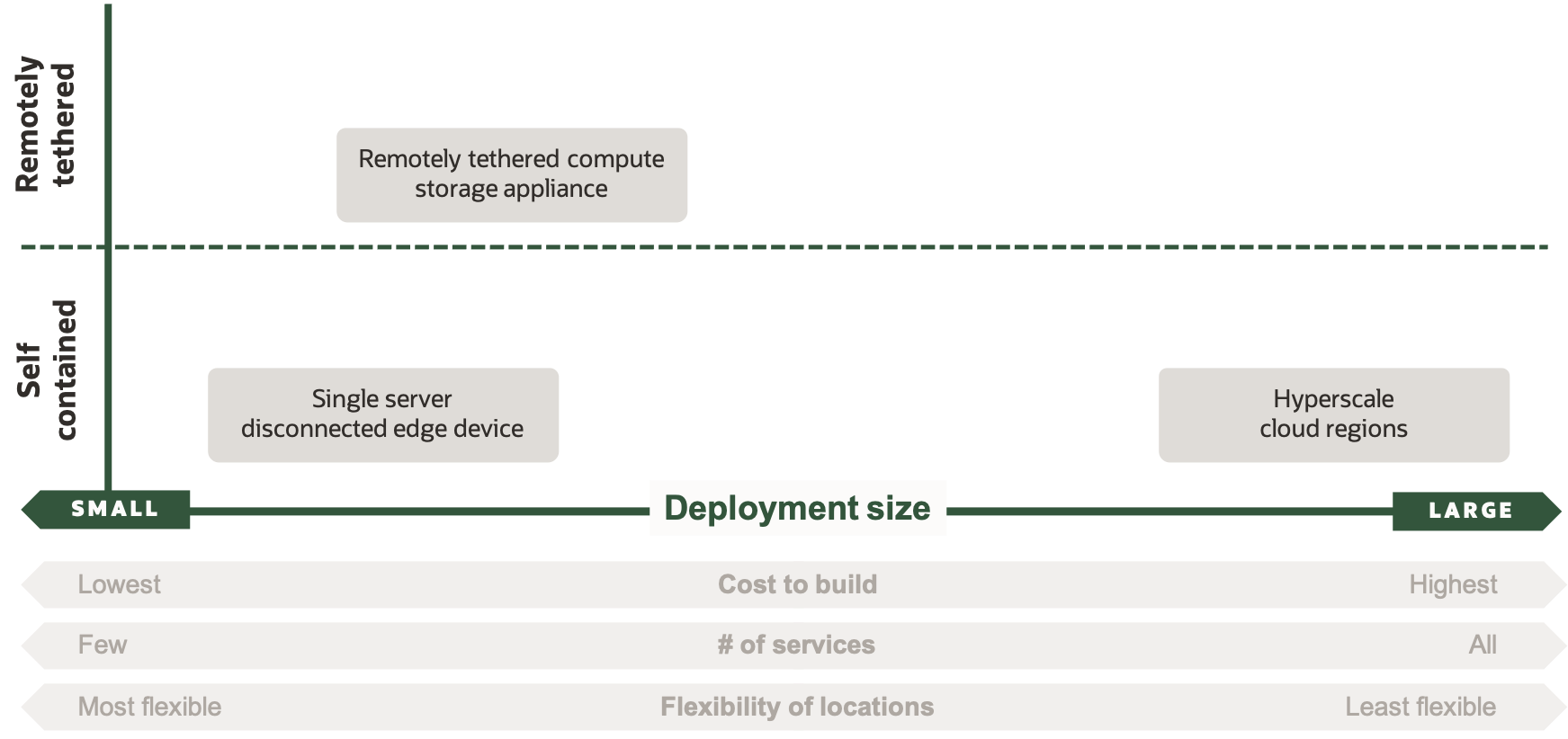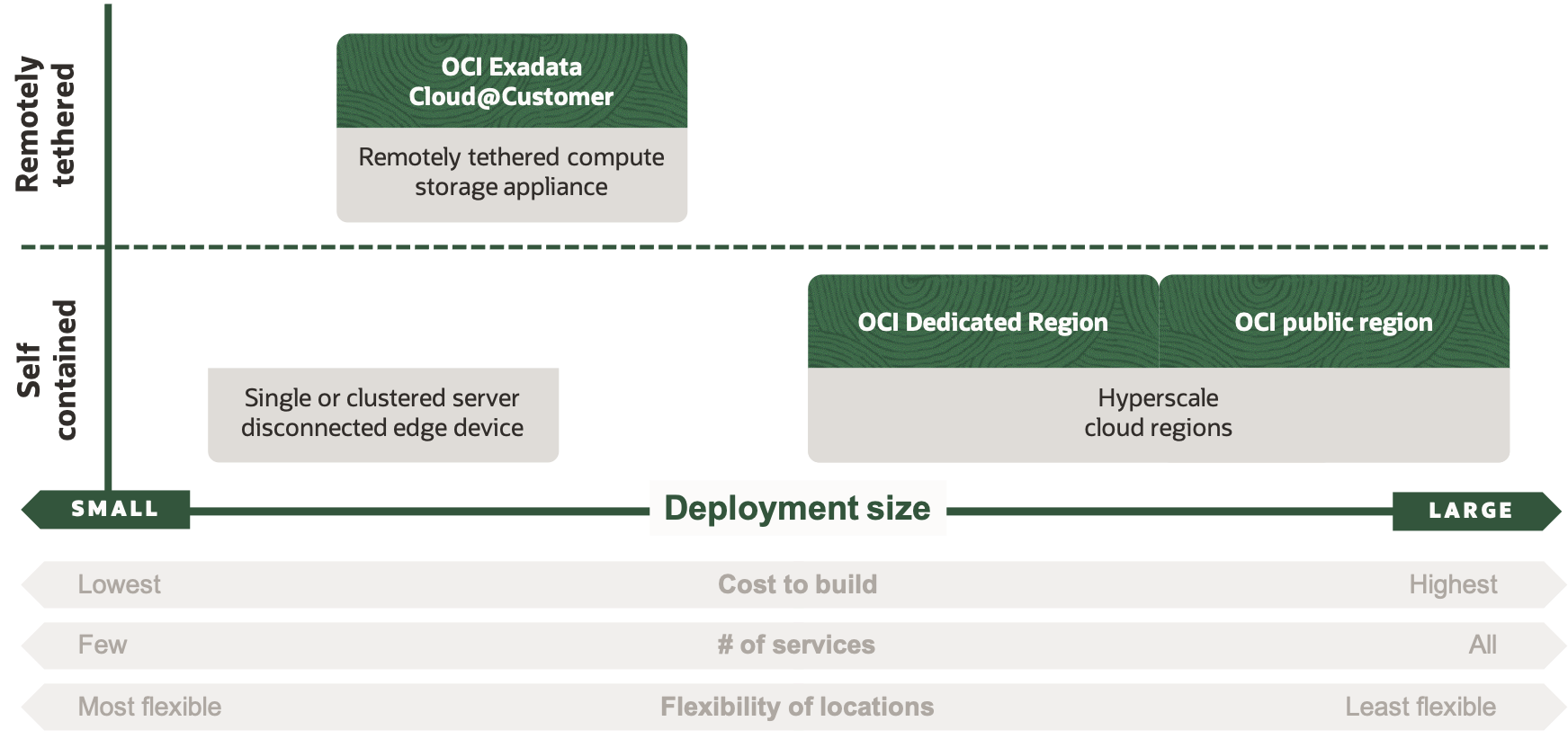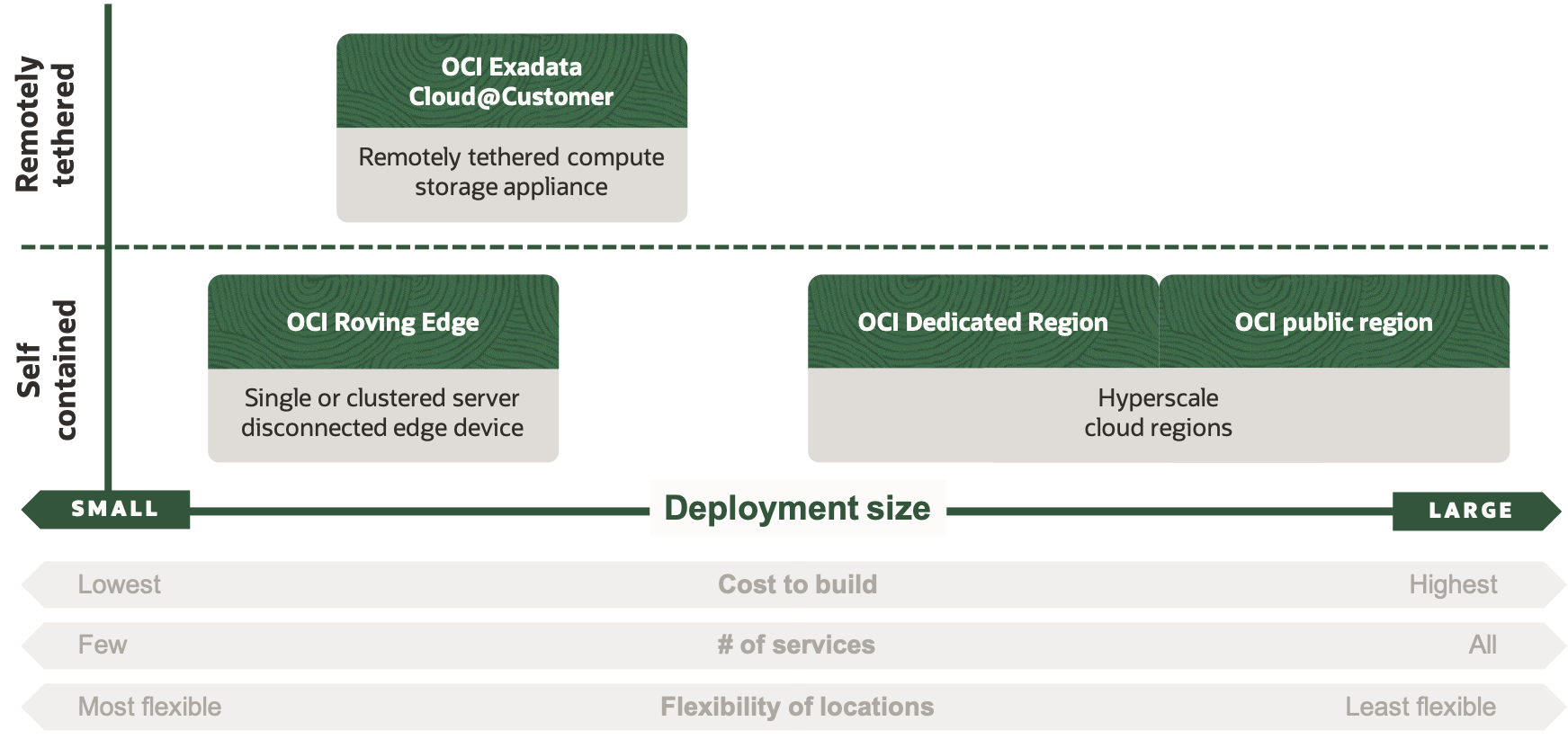Hybrid cloud and edge computing are increasingly important use cases for global organizations. Yet, what the market has offered to date has forced customers to make unnecessary trade-offs. Customer requirements for specialized deployments, data locality, immediate use of locally generated data without cloud latency, and disconnected or intermittently connected environments have driven Oracle’s strategy and product design.
In this post, I provide an update on our approach to hybrid cloud, our momentum, and highlight a newly introduced product in our hybrid cloud portfolio. The following categories of cloud solutions are displayed in relation to their deployment sizes and connectivity requirements.

What Oracle provides
The size of a deployment directly impacts its strengths and limitations. It’s more expensive and complex to build large hyperscale data centers, so fewer are built, but they can easily provide and integrate a vast array of services. On the other hand, you can deploy a single server or cluster almost anywhere inexpensively, but they’re naturally limited to providing fewer services. With deployment size, connection requirements affect the scope and capabilities of hybrid cloud solutions. They can be self-contained with no external requirements or tethered to their public cloud regions.
Oracle has made some different choices with our hybrid cloud products. With our hyperscale public cloud for commercial and government organizations, Oracle has two hybrid cloud products that cover the upper-right and lower-left corners of the diagram.

Dedicated Region Cloud@Customer
Oracle Dedicated Region Cloud@Customer offers Oracle’s complete portfolio of public cloud services and Oracle Fusion SaaS applications in a customer data center. Managed by Oracle, Dedicated Region Cloud@Customer functions independently, with all data, services, and the control plane on-premises. APIs continue to function, even when disconnected from Oracle. Customer costs are based solely on consumption. Oracle Cloud Infrastructure (OCI) manages capacity just as we do in our public cloud regions.
This combination of characteristics helps customers keep running their current applications, while building new, potentially cloud-native, applications side by side.
Nomura Research Institute (NRI), Ltd., the largest consulting firm and IT solutions provider in Japan, one of the first customers of Dedicated Region Cloud@Customer, has now completed their deployment and is moving key financial applications into the environment. They look to actively modernize their applications in parallel.
Australian Data Centres, which hosts the Australian Government’s IT, chose Dedicated Region over building their own solution with bespoke or hypervisor-based technologies. The economics and breadth of services made the decision to choose OCI simple.
VMware Solution
Oracle Cloud VMware Solution is another hybrid cloud product that a customer can deploy either within their public cloud tenancy or in their Dedicated Region. It provides a customer-managed, native VMware-based cloud environment with full administrative access and complete control over upgrades and operations using familiar VMware tools. VMware Solution features an isolated environment within a region; OCI has no access to the data or the environment. Everything is included in one flat monthly rate.
With it, customers can rely on Oracle to incrementally modernize their physical infrastructure while maintaining a consistent set of management processes and tools and maintaining control over their VMware software and upgrade timelines.
Demand for the Oracle Cloud VMware Solution has exceeded our forecasts, with deployments in dozens of countries across all industry verticals. Migration of entire data centers and capacity expansion of existing data centers are the main drivers of moving VMware workloads to the cloud, along with business continuity, disaster recovery, and virtual desktop infrastructure. Oracle’s layer 2 networking at cloud scale also enables customers to migrate many existing applications without substantially rearchitecting them. It also provides a foundation for unparalleled compatibility and customer control over their cloud VMware deployments.
Rumo Malha Norte S.A, a Brazilian transport and railway leader, has migrated multiple applications to Oracle Cloud VMware Solution as part of its initiative to move to the cloud from its legacy data centers. It has moved core business-critical applications, including Oracle applications, SQL Server, and other virtualized workloads, from their on-premises VMware environment to Oracle Cloud VMware Solution.
Chile-based Entel Perú, a Latin American company, has been meeting rising demand for mobile services by quickly migrating VMware-based workloads to Oracle Cloud Infrastructure. These workloads include critical applications, such as billing and inventory management, that it had previously run on-premises. Instead of taking years to rearchitect multiple applications and technology platforms to get them to run natively in the cloud, Entel has migrated most of its VMware environments in a matter of weeks, because in part of their total control of the environment. This control over software, versioning, and updates, similar to their-on premises environment, makes for quick trouble-free migrations and lets them upgrade on their own timeline.
Exadata Cloud@Customer
Oracle Exadata Cloud@Customer delivers high-performance Exadata cloud service capabilities directly to a customer data center. The service helps address requirements for strict data sovereignty and security by retaining data on-premises while providing operational management with an Oracle-managed cloud service. Hardware, software, and services are delivered at one flat monthly rate.
This simplicity enables customers to modernize while reducing the burden of database infrastructure. Customers can simply connect their applications to the Exadata without rearchitecture.
Crédit Agricole CIB is the Corporate and Investment Banking arm of the Crédit Agricole Group, one of the world’s largest banks. They moved to Exadata Cloud@Customer to improve their accounting information system performance while reducing operational costs.
With these options, Oracle also recently introduced a new product to our hybrid and edge portfolio that fulfills the needs of the small, self-contained lower left corner of the diagram: Oracle Roving Edge Infrastructure.
Oracle Roving Edge Infrastructure
Oracle Roving Edge Infrastructure extends fundamental OCI capabilities to a ruggedized device. This device enables applications to function even in locations without network connectivity. It also provides a powerful local compute platform for use cases where the volume of data and network latency make moving data to the public cloud, processing it there, and taking local action on the results too slow or impossible.

Roving Edge Infrastructure devices extend an Oracle Cloud tenancy with compatible core cloud services including compute, block and object storage, networking, and identity. You can build and test applications using the tools and components you already use and then deploy them to a Roving Edge Device (RED). High-performance databases like Oracle Database Enterprise Edition, analytics and visualization tools like Oracle Analytics Server, and data management utilities like Oracle GoldenGate can now all run seamlessly in edge environments with Roving Edge Infrastructure. Training a machine learning model is often resource-intensive, but these models can now be built using the elastic resources in the public cloud, deployed to a RED in the field for low-latency local use, and later improved when local data captured on the RED is synchronized back to Oracle Cloud Infrastructure Object Storage.
Oracle Roving Edge Infrastructure is designed to address the complete life cycle of complex distributed compute- and data-intensive workflows between the field, edge locations, on-premises data centers, and the cloud. Compared with other ruggedized edge devices, Roving Edge Device delivers superior performance and better value with more processing power and storage, is lighter in weight, and has consistent, service-based pricing.
Edge computing comparison
| Oracle Roving Edge Infrastructure | AWS Snowball Edge Compute Optimized11 | Azure Stack Edge Pro22 | |
|---|---|---|---|
| CPU Cores | 40 | 26 | 20 |
| DRAM | 512 GB | 208 GB | 128 GB |
| Storage | 61 TB NVMe 2 x 1 TB NVMe (System OS) |
42 TB HDD 7.68 NVMe for VMs |
12.8 TB NVMe for local cache |
| AI/ML Support | NVIDIA T4 Tensor Core GPU | NVIDIA Tesla V100 GPU | Intel Arria 10 GX FPGA or NVIDIA T4 GPU |
| Clustering | 5-15 node clusters | 5-10 node clusters | |
Roving Edge Infrastructure can accelerate data collection, analysis, and strategic decision-making even in the most remote environments. Applications across many industries require low-latency data processing and analytics or data collection and migration of large sets data into Oracle Cloud.
-
The public sector, including government, disaster response, and defense, increasingly relies on data processing and analysis in the field, including spatial data and data streams from cameras, sensors, and Internet of Things devices.
-
Oil and gas companies have intense needs for image and 3D data capture, analytics, and machine learning in remote locations without connectivity, where data is often captured on site, analyzed, and then sent back to the cloud for further analysis.
-
Telecommunication providers need low-latency data processing near base stations.
-
Healthcare providers can use onsite storage and processing for digital imaging and diagnostics before sending data to the cloud.
-
Hospitality, Agriculture, Transportation, and Logistics all have similar needs.
Roving Edge Devices can also be deployed in larger clusters. Roving Edge Infrastructure is priced at $160 a day per node with no up-front charges.
Oracle hybrid cloud versus AWS
Oracle’s approach to hybrid cloud contrasts with Amazon Web Services (AWS). AWS only recently acknowledged the necessity to address hybrid cloud use cases. Their architectural bias toward a limited number of hyperscale public cloud regions leads their hybrid cloud services to remain limited in performance, number of services provided, and regional availability. Their hybrid cloud offerings remain tethered to their public cloud regions, with control planes and data intermingled between the edge and core. Pricing remains complex, with regional dependencies and AWS Outposts requiring customers to specify fixed rack hardware capacity at the time of order.
| Scale | Available services | Service locations | Control plane | Operational control | Data locality | Self-contained | Pricing | |
|---|---|---|---|---|---|---|---|---|
| General workloads | ||||||||
| Oracle Dedicated Region | Data center | All OCI services | Any customer premises | On-premises | OCI-managed | On-premises data and metadata | Self-contained; disconnected functionality | Consumption-based (globally consistent) |
| AWS Outposts3 | Node or Rack | Subset of AWS services | Customer premises tethered to a subset of AWS regions | At AWS | AWS-managed | On-premises; metadata, EBS snapshots in cloud | Degraded control when disconnected | Monthly rate by ordered hardware capacity + AWS service fees (by region) |
| Database-specific workloads | ||||||||
| Oracle Exadata Cloud@Customer | Rack | Oracle Exadata Cloud, Oracle Autonomous Database | Any customer premises tethered to any OCI commercial region | At OCI | OCI-managed | On-premises data; resiliency locally or in cloud | Operational databases, but reduced control when disconnected | Monthly rate (globally consistent) |
| RDS on AWS Outposts4 | Rack | MySQL, PostgreSQL | Customer premises tethered to a subset of AWS regions | At AWS | AWS-managed | On-premises data; metadata, snapshots in cloud | Operational databases, but limited control when disconnected | Monthly rate by ordered hardware capacity + AWS service fees (by region) |
| VMware in the cloud | ||||||||
| Oracle Cloud VMware Solution | Cluster (3–64 nodes) | VMware Cloud + compute, storage, network | All commercial + 2 US Gov OCI regions + DRCC | Within environment | Customer-managed admin & upgrades | Within environment | Self-contained; No OCI access | Monthly rate (globally consistent) |
| VMware Cloud on AWS5 | Cluster (3–16 nodes) | Limited access to VMware platform | Subset of AWS regions | At AWS | AWS-managed environment | AWS-managed | AWS access | Hourly rate (by region) to VMware + AWS fees (by region) |
| Edge computing | ||||||||
| Oracle Roving Edge Infrastructure | Node or Cluster | Compute + Storage + Fleet management | US Government OCI regions | US Government OCI regions | On-device + in OCI region | On-device data | Self-contained; disconnected functinoality | Daily rate (globally consistent) |
| AWS Snowball Edge6 | Node or Cluster | Compute + Storage | Subset of AWS regions | Supported regions | On-device + in AWS region | On-device data | Self-contained; disconnected functionality | Daily rate (by region) |
Oracle’s offerings consistently have higher performance, include more services, operate more independently from public cloud regions, provide better isolation, and have simpler OPEX-based pricing models.
Next steps
Thank you for letting me share these announcements with you today. To learn more or get hands-on, use the following resources:
-
Access our resource center for hybrid cloud product details and testimonials on hybrid cloud and edge computing.
-
Get started with Oracle Cloud Infrastructure today with our Oracle Cloud Free Tier.
-Clay
Sources
As of February 2021:
-
Snowball Edge Compute Optimized Specifications and Using an AWS Snowball Edge Cluster
-
What is Azure Stack Edge Pro with GPU?, Azure Stack Edge pricing, and Technical specifications and compliance for Azure Stack Edge Pro with GPU
-
AWS Outposts Features, AWS Outposts FAQs, AWS Outposts pricing, and AWS Outposts Documentation
-
Amazon RDS on Outposts FAQs and Amazon RDS on Outposts pricing
-
VMware Cloud on AWS Configuration Limits, VMware Cloud on AWS Technical Overview, VMware Cloud on AWS Service Description, VMware Cloud on AWS FAQ, Roles and Permissions in the SDDC, VMware Cloud on AWS FAQs, VMware Cloud on AWS Outposts FAQ
-
Snowball Edge Compute Optimized Specifications and Using an AWS Snowball Edge Cluster
